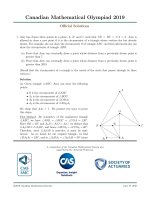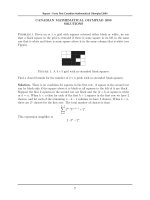Đề thi và đáp án CMO năm 2015
Bạn đang xem bản rút gọn của tài liệu. Xem và tải ngay bản đầy đủ của tài liệu tại đây (714.94 KB, 5 trang )
<span class='text_page_counter'>(1)</span><div class='page_container' data-page=1>
Solutions to 2015 CMO (DRAFT—as of April 6, 2015)
Problem 1. Let<sub>N</sub>={1,2,3, . . .}be the set of positive integers. Find all functionsf, defined
on <sub>N</sub> and taking values in <sub>N</sub>, such that (n−1)2 <sub>< f</sub><sub>(</sub><sub>n</sub><sub>)</sub><sub>f</sub><sub>(</sub><sub>f</sub><sub>(</sub><sub>n</sub><sub>))</sub> <sub>< n</sub>2<sub>+</sub><sub>n</sub> <sub>for every positive</sub>
integer n.
Solution. The only such function is f(n) =n.
Assume that f satisfies the given condition. It will be shown by induction that f(n) = n
for all n ∈ <sub>N</sub>. Substituting n = 1 yields that 0 < f(1)f(f(1)) < 2 which implies the base
case f(1) = 1. Now assume that f(k) = k for all k < n and assume for contradiction that
f(n)6=n.
On the one hand, iff(n)≤n−1 thenf(f(n)) = f(n) andf(n)f(f(n)) =f(n)2 <sub>≤</sub><sub>(</sub><sub>n</sub><sub>−1)</sub>2
which is a contradiction. On the other hand, if f(n)≥n+ 1 then there are several ways to
proceed.
Method 1: Assume f(n) = M ≥ n+ 1. Then (n + 1)f(M) ≤ f(n)f(f(n)) < n2 <sub>+</sub><sub>n</sub><sub>.</sub>
Therefore f(M) < n, and hence f(f(M)) = f(M) and f(M)f(f(M)) = f(M)2 <sub>< n</sub>2 <sub>≤</sub>
(M −1)2, which is a contradiction. This completes the induction.
Method 2: First note that if|a−b|>1, then the intervals ((a−1)2<sub>, a</sub>2<sub>+</sub><sub>a</sub><sub>) and ((</sub><sub>b</sub><sub>−1)</sub>2<sub>, b</sub>2<sub>+</sub><sub>b</sub><sub>)</sub>
are disjoint which implies that f(a) and f(b) cannot be equal.
Assuming f(n)≥n+ 1, it follows that f(f(n))< n<sub>f</sub>2<sub>(n)</sub>+n ≤n. This implies that for some
a ≤n−1, f(a) = f(f(n)) which is a contradiction since |f(n)−a| ≥n+ 1−a ≥2. This
completes the induction.
Method 3: Assuming f(n)≥ n+ 1, it follows that f(f(n))< n<sub>f</sub>2<sub>(n)</sub>+n ≤n and f(f(f(n))) =
f(f(n)). This implies that (f(n)−1)2 <sub>< f</sub><sub>(</sub><sub>f</sub><sub>(</sub><sub>n</sub><sub>))</sub><sub>f</sub><sub>(</sub><sub>f</sub><sub>(</sub><sub>f</sub><sub>(</sub><sub>n</sub><sub>))) =</sub><sub>f</sub><sub>(</sub><sub>f</sub><sub>(</sub><sub>n</sub><sub>))</sub>2 <sub>< f</sub><sub>(</sub><sub>n</sub><sub>)</sub>2<sub>+</sub><sub>f</sub><sub>(</sub><sub>n</sub><sub>) and</sub>
therefore that f(f(n)) = f(n) since f(n)2 is the unique square satisfying this constraint.
This implies that f(n)f(f(n)) =f(n)2 <sub>≥</sub> <sub>(</sub><sub>n</sub><sub>+ 1)</sub>2 <sub>which is a contradiction, completing the</sub>
induction.
Problem 2. Let ABC be an acute-angled triangle with altitudes AD, BE, and CF. Let H
be the orthocentre, that is, the point where the altitudes meet. Prove that
AB·AC+BC·BA+CA·CB
AH·AD+BH·BE+CH ·CF ≤ 2.
Solution. Method 1: LetAB =c, AC =b, and BC =a denote the three side lengths of
the triangle.
As <sub>∠</sub>BF H =<sub>∠</sub>BDH = 90◦, F HDB is a cyclic quadrilateral. By the Power-of-a-Point
Theorem, AH ·AD =AF ·AB. (We can derive this result in other ways: for example, see
Method 2, below.)
</div>
<span class='text_page_counter'>(2)</span><div class='page_container' data-page=2>
By the Cosine Law, cos<sub>∠</sub>A= b
2<sub>+</sub><sub>c</sub>2<sub>−</sub><sub>a</sub>2
2bc , which implies that AH·AD=
b2+c2−a2
2 .
By symmetry, we can show that BH·BE = a
2<sub>+</sub><sub>c</sub>2<sub>−</sub><sub>b</sub>2
2 and CH ·CF =
a2 <sub>+</sub><sub>b</sub>2<sub>−</sub><sub>c</sub>2
2 .
Hence,
AH·AD+BH·BE+CH ·CF = b
2<sub>+</sub><sub>c</sub>2<sub>−</sub><sub>a</sub>2
2 +
a2<sub>+</sub><sub>c</sub>2<sub>−</sub><sub>b</sub>2
2 +
a2 <sub>+</sub><sub>b</sub>2<sub>−</sub><sub>c</sub>2
2
= a
2<sub>+</sub><sub>b</sub>2<sub>+</sub><sub>c</sub>2
2 . (1)
Our desired inequality, AB·AC+BC·BA+CA·CB
AH·AD+BH·BE+CH ·CF ≤2, is equivalent to the inequality
cb+ac+ba
a2<sub>+b</sub>2<sub>+c</sub>2
2
≤2, which simplifies to 2a2+ 2b2+ 2c2 ≥2ab+ 2bc+ 2ca.
But this last inequality is easy to prove, as it is equivalent to (a−b)2<sub>+(</sub><sub>a</sub><sub>−</sub><sub>c</sub><sub>)</sub>2<sub>+(</sub><sub>b</sub><sub>−</sub><sub>c</sub><sub>)</sub>2 <sub>≥</sub><sub>0.</sub>
Therefore, we have established the desired inequality. The proof also shows that equality
occurs if and only if a=b=c, i.e.,4ABC is equilateral.
Method 2: Observe that
AE
AH = cos(∠HAE) =
AD
AC and
AF
AH = cos(∠HAF) =
AD
AB.
It follows that
AC·AE = AH·AD = AB·AF .
By symmetry, we similarly have
BC·BD = BH·BE = BF ·BA and CD·CB = CH ·CF = CE·CA .
Therefore
2(AH·AD+BH·BE+CH ·CF)
= AB(AF +BF) + AC(AE+CE) + BC(BD+CD)
= AB2 + AC2 + BC2.
This proves Equation (1) in Method 1. The rest of the proof is the same as the part of the
proof of Method 1 that follows Equation (1).
</div>
<span class='text_page_counter'>(3)</span><div class='page_container' data-page=3>
Solution. We shall prove that the answer is 2n+ 2. Number the rows in increasing order,
from top to bottom, and number the columns from left to right. By symmetry, we may (and
shall) assume that the turtle starts in the top right corner square.
First we shall prove that some row or column must be entered at least 2n+ 2 times. Let
m= 4n+ 2. First note that each time the turtle moves, she enters either a row or a column.
Letri denote the number of times the turtle enters row i, and let ci be similarly defined for
columni. Since the turtle moves m2 <sub>times,</sub>
r1 +r2+· · ·+rm+c1 +c2+· · ·+cm =m2.
Now note that each time the turtle enters column 1, the next column she enters must be
column 2. Therefore c1 is equal to the number of times the turtle enters column 2 from
column 1. Furthermore, the turtle must enter column 2 from column 3 at least once, which
implies that c2 > c1. Therefore since the 2m terms ri and ci are not all equal, one must be
strictly greater than m2<sub>/</sub><sub>(2</sub><sub>m</sub><sub>) = 2</sub><sub>n</sub><sub>+ 1 and therefore at least 2</sub><sub>n</sub><sub>+ 2.</sub>
Now we construct an example to show that it is possible that no row or column is entered
more than 2n+ 2 times. Partition the square grid into four (2n+ 1)×(2n+ 1) quadrants
A, B, C, and D, containing the upper left, upper right, lower left, and lower right corners,
respectively. The turtle begins at the top right corner square of B, moves one square down,
and then moves left through the whole second row of B. She then moves one square down
and moves right through the whole third row of B. She continues in this pattern, moving
through each remaining row of B in succession and moving one square down when each row
is completed. Since 2n+ 1 is odd, the turtle ends at the bottom right corner ofB. She then
moves one square down intoDand through each column ofD in turn, moving one square to
the left when each column is completed. She ends at the lower left corner of D and moves
left into C and through the rows of C, moving one square up when each row is completed,
ending in the upper left corner of C. She then enters A and moves through the columns of
</div>
<span class='text_page_counter'>(4)</span><div class='page_container' data-page=4>
Problem 3: the case n = 3
start
Problem 4. Let ABC be an acute-angled triangle with circumcenter O. Let Γ be a circle
with centre on the altitude from A in ABC, passing through vertex A and points P and Q
on sides AB and AC. Assume that BP ·CQ = AP ·AQ. Prove that Γ is tangent to the
circumcircle of triangle BOC.
Solution. Let ω be the circumcircle of BOC. Let M be the point diametrically opposite
to O on ω and let the line AM intersect ω at M and K. Since O is the circumcenter of
ABC, it follows that OB =OC and therefore that O is the midpoint of the arc \BOC of ω.
Since M is diametrically opposite to O, it follows that M is the midpoint of the arc BM C\
of ω. This implies since K is onω that KM is the bisector of <sub>∠</sub>BKC.Since K is onω, this
implies that <sub>∠</sub>BKM =<sub>∠</sub>CKM, i.e. KM is the bisector of <sub>∠</sub>BKC.
Since O is the circumcenter of ABC, it follows that <sub>∠</sub>BOC = 2<sub>∠</sub>BAC. Since B, K, O
and C all lie on ω, it also follows that <sub>∠</sub>BKC = <sub>∠</sub>BOC = 2<sub>∠</sub>BAC. Since KM bisects
∠BKC, it follows that <sub>∠</sub>BKM =<sub>∠</sub>CKM = <sub>∠</sub>BAC. The fact that A, K and M lie on a
line therefore implies that<sub>∠</sub>AKB =<sub>∠</sub>AKC = 180◦−<sub>∠</sub>BAC. Now it follows that
∠KBA= 180◦−<sub>∠</sub>AKB−<sub>∠</sub>KAB =<sub>∠</sub>BAC −<sub>∠</sub>KAB=<sub>∠</sub>KAC.
This implies that triangles KBA and KAC are similar. Rearranging the condition in the
problem statement yields thatBP/AP =AQ/CQwhich, when combined with the fact that
KBA and KAC are similar, implies that triangles KP A and KQC are similar. Therefore
∠KP A=<sub>∠</sub>KQC = 180◦−<sub>∠</sub>KQA which implies that K lies on Γ.
</div>
<span class='text_page_counter'>(5)</span><div class='page_container' data-page=5>
∠KSA. Therefore<sub>∠</sub>T KM =<sub>∠</sub>SKAwhich implies thatS,T andK are collinear. Therefore
Γ and ω intersect at a point K which lies on the line ST connecting the centres of the two
circles. This implies that the circles Γ and ω are tangent atK.
Problem 5. Let p be a prime number for which p−<sub>2</sub>1 is also prime, and let a, b, c be integers
not divisible by p. Prove that there are at most 1 +√2p positive integers n such that n < p
and p divides an+bn+cn.
Solution. First suppose b ≡ ±a (mod p) and c ≡ ±b (mod p). Then, for any n, we have
an+bn+cn ≡ ±an or±3an (mod p). We are given that p6= 3 (since 3−1
2 is not prime) and
p6 |a, so it follows thatan<sub>+</sub><sub>b</sub>n<sub>+</sub><sub>c</sub>n <sub>6≡</sub><sub>0 (mod</sub> <sub>p</sub><sub>). The claim is trivial in this case. Otherwise,</sub>
we may assume without loss of generality that b 6≡ ±a (mod p) =⇒ ba−1 <sub>6≡ ±1 (mod</sub> <sub>p</sub><sub>).</sub>
Now let q = p−<sub>2</sub>1. By Fermat’s little theorem, we know that the order of ba−1 mod p
divides p−1 = 2q. However, since ba−1 <sub>6≡ ±1 (mod</sub> <sub>p</sub><sub>), the order of</sub> <sub>ba</sub>−1 <sub>does not divide 2.</sub>
Thus, the order must be either q or 2q.
Next, let S denote the set of positive integers n < psuch thatan+bn+cn ≡0 (modp),
and let st denote the number of ordered pairs (i, j)⊂S such that i−j ≡t (mod p−1).
Lemma: If t is a positive integer less than 2q and not equal to q, then st ≤2.
Proof: Consider i, j ∈S with j −i≡t (mod p−1). Then we have
ai+bi+ci ≡0 (mod p)
=⇒ aicj−i+bicj−i+cj ≡0 (mod p)
=⇒ aicj−i+bicj−i−aj −bj ≡0 (mod p)
=⇒ ai· ct−at
≡bi· bt−ct
(mod p).
If ct ≡ at (mod p), then this implies ct ≡ bt (mod p) as well, so (ab−1)t ≡ 1 (modp).
However, we know the order of ab−1 <sub>is</sub> <sub>q</sub> <sub>or 2</sub><sub>q</sub><sub>, and</sub> <sub>q</sub> <sub>6 |</sub><sub>t</sub><sub>, so this impossible. Thus, we can</sub>
write
(ab−1)i ≡ bt−ct· ct−at−1 (mod p).
For a fixed t, the right-hand side of this equation is fixed, so (ab−1)i is also fixed. Since the
order of ab−1 <sub>is either</sub> <sub>q</sub> <sub>or 2</sub><sub>q</sub><sub>, it follows that there are at most 2 solutions for</sub> <sub>i</sub><sub>, and the</sub>
lemma is proven.
Now, for each element i inS, there are at least |S| −2 other elements that differ from i by
a quantity other than q (mod p−1). Therefore, the lemma implies that
|S| ·(|S| −2) ≤ X
t6=q
st ≤ 2·(p−2)
</div>
<!--links-->









